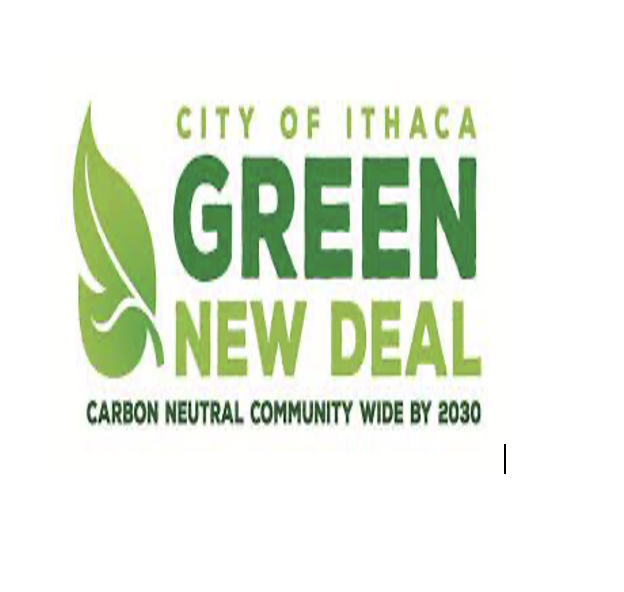Opinion: Local And Green. Can Amherst Be As Bold As Ithaca?

Photo: cityofithaca.org
The following column appeared previously in the Amherst Bulletin.

In February, major news outlets reported that, according to a new statement from the UN International Panel on Climate Change, humanity has a rapidly narrowing window to avert a harrowing future, unless major transformative solutions are undertaken, and that adaptation efforts must be paired with radical action to cut carbon pollution.
Realizing that half-measures are not adequate, the city of Ithaca, New York has embarked on a program to fulfill its bold climate action goals (carbon neutrality by 2030) by adopting a Green New Deal, including a plan to retrofit and electrify 6,000 buildings.
The plan, called the Energy Efficiency Retrofit and Thermal Load Electrification Plan, is the brainchild of Luis Aguirre-Torres, hired a year ago by the city as sustainability director to implement Ithaca’s building decarbonization. No stranger to climate action, Aguirre-Torres spent 12 years assisting Latin American countries develop innovation and climate change legislation, and providing technical assistance for the design, implementation and financing of long-term climate change and climate justice projects.
He is the founder of GreenMomentum, a market-intelligence and innovation firm focused on climate change and clean technology, as well as Cleantech Challenge and Cleantech Labs, the largest cleantech and hard-tech business incubators in Latin America.
In addition to adopting the Efficiency and Electrification Plan, the Ithaca Common Council approved the appointment of a minority-led firm, Brooklyn-based BlocPower as program manager, along with a consortium of businesses, nonprofits and the U.S. Department of Energy.
According to Ithaca’s request for proposals (the contract is in the process of being signed), BlocPower would be in charge of providing or upgrading the building envelope, windows, energy recovery ventilation, LED conversion, electric panels, air or ground source heat pumps and heat pump hot water heaters, electric cooktops, dryers, solar panels and storage, and potentially bidirectional EV charging and microgrids.
The program will employ specialized software to analyze and prioritize buildings, as well as innovative mechanisms for the bulk purchasing of materials and appliances.
Ithaca will seek to electrify 6,000 buildings, starting with 1,500 in a first phase.
Rather than counting on state-sponsored incentive programs, which tend to be small and bogged down with bureaucratic delay, Ithaca is looking to private equity to accelerate and scale up the work. One method of doing so is by bulk purchasing from an array of private companies, in order to reduce risk.
Creative financing appears to be the key to Ithaca’s program acceleration. The total projected budget is $600 million, $100 million of which has been committed and $500 million of which the city has obtained “soft commitments.” The private funds invested don’t go to the city, but will be managed by BlocPower. In this way, the city avoids potential financial risk. Obtaining financing from private equity greatly affects the scale of action that can be undertaken, including the ability to do the up front bulk purchasing necessary. BlocPower will deal with the start-up costs, including the organizing of a local labor force.
Property owners will be offered low- or no-interest loans or leasing options for upgrades such as heat pumps, electric appliances, chargers and solar panels that will provide substantial savings in lowered energy costs for those in the long run. Low-income residents will have special provisions such as low interest rates.
Of course there are always challenges. They include, at least, absentee or resistant landlords, consumer resistance to converting from natural gas, the capacity and flexibility of the grid when faced with adding many more electrons, and finding and training some 400 workers.
Ithaca and Amherst
Amherst’s bold goals, adopted in November of 2019 by the Town Council, are based on Ithaca’s. Though Amherst’s goal of carbon neutrality is by 2050, the goals include a caveat that we “be prepared to achieve carbon neutrality as early as 2030 by planning and advocating for state and federal action and taking advantage of technological advances.”
By adopting this language, the council recognized the need to accelerate our action if at all possible. A project of this scale and size may also be something the soon-to-be-launched multi-municipal (Amherst, Northampton and Pelham) energy aggregation may want to look at.
To learn more about the initiative in Ithica, Local Energy Advocates of Western MA is planning a public event on March 15, 7-8:30 p.m., “Ithaca’s Green New Deal.” Featured will be Luis Aguirre-Torres, Ithaca’s sustainability director and creator of Ithaca’s Electrification Program, and Ariel Kalishman Walsh and Clare Doyle Dowd from BlocPower. The Zoom registration information is available at the LEA website.
The founders of LEA were among the initiators of a local effort to create an inter-municipal aggregation of electricity for Northampton, Amherst and Pelham residents. LEA plans to continue working with the municipalities on aggregation and other “scaleable” efforts to reduce their collective greenhouse gas emissions.
Darcy DuMont is a founding member of Local Energy Advocates of Western MA and of Zero Waste Amherst. As a Town Councilor, she sponsored legislation creating the Amherst Energy and Climate Action Committee.

2 thoughts on “Opinion: Local And Green. Can Amherst Be As Bold As Ithaca?”